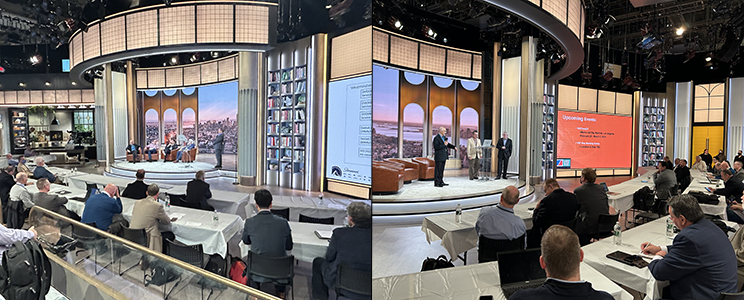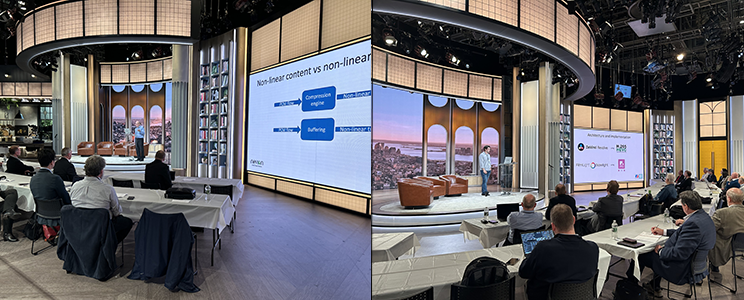2022 VSF October Meeting Series – New York, New York, USA
October 17, 2022
Meeting Hosted By: CBS, 524 West 57th Street, New York, NY 10019
 |
Photos from VSF October Meeting Series held at CBS
in New York on October 17, 2022 |
Presentations
- Meeting Agenda (pdf, 225k)
Login is required to access the following meeting documents:
-
An overview of the upcoming Source Adaptation VSF TR (pdf, 314k)
Ciro A. Noronha, Ph.D. – Cobalt Digital - RIST Activity Group Update (pdf, 44k)
Rick Ackermans – CBS - SDI, 2110, IPMX, NDI, CDI, XDI and the Future of Media Data Interfacing. (pdf, 2.31Mb)
Andy Rayner – Nevion - SMPTE ST 2110 over WAN Update (pdf, 2.23Mb)
Andy Rayner – Nevion - Hauppauge Overview (pdf, 5.51Mb)
- IPMX Activity Group Update (pdf, 3.38Mb)
Jack Douglass PacketStorm - Color in the Cloud: Motion Picture and Television Color Grading and Finishing on AWS (pdf, 2.22Mb)
Robert Raver – Amazon - GCCG Activity Group Update (pdf, 384k)
John Mailhot-Imagine Communications - VidTrans23 Update/Discussion (pdf, 840k)
Wes Simpson- Telecom Product Consulting - Panel Discussion ‘Coverage of Queen Elisabeth’s Funeral using the Internet” (pdf, 9.8Mb)
Panelists – Key people from CBS News - The Configuration Conundrum – How day one and ongoing facility configuration is becoming a number-one user concern. (pdf, 101k)
Brad Gilmer – Gilmer & Associates - RFC for RIST's EAP SHA256-SRP6a Authorization Protocol Expands Potential Applications (pdf, 1.44Mb)
Sergio Ammirata, Ph.D - SipRadius
 |
 |
| Photos from VSF October Meeting Series held at CBS in New York on October 17, 2022 |
RFC for RIST's EAP SHA256-SRP6a Authorization Protocol Expands Potential Applications
Synopsis: Video Services Forum, as part of its RIST error correcting protocol, is submitting an Internet RFC for a new authorization protocol, called EAP SHA256-SRP6a. It leverages existing protocols. This short session will contain an overview of the authorization protocol. The session's main focus will be upon the application of the authorization protocol. From the point of view of transport only applications, it adds an individualized and highly secure gatekeeper to guard entry to streaming media. The authorization is specifically designed to be multicast friendly. In a corporate intranet environment, this can provide user screened access to live streams. It could even be adopted in a cable TV infrastructure to allow/disallow specific set top box/user access to multicast programming. With use of a library, such as libRIST, applications that may benefit from error corrected programs but which have high user security needs could add RIST. Secure, speedy and highly-resilient file transfer, for example, could incorporate RIST. udp virtual private networking could incorpate an error correction feature, with control over buffering requirements. Any network communications application requiring a strong authorization "gatekeeper" can therefore benefit from error correction at the cost of a small buffer.
SDI, 2110, IPMX, NDI, CDI, xDI and the future of media data interfacing.
Synopsis: As we are evolving the ways of connecting live media flows, there are multiple considerations to be taken into account.
Furthermore, as we evolve from ‘linear’ to compute based processing, there are further considerations on the optimising of compute-friendly data interfacing. Some of our traditional broadcast signal thinking needs to evolve as we start to evolve towards a non-linear chain.
In addition, some newer connectivity technologies such as NDI typically use different protocols and principles (TCP and VBR) which can impact system architecture. The use of compression in the chain is also a consideration.
This presentation will explore the application spaces for different connectivity technologies and how these are likely to need to evolve as we move forwards.
An overview of the upcoming Source Adaptation VSF TR
Synopsis: The RIST AG has completed the work on the upcoming TR-06-4 Part 1, Source Adaptation. The purpose of this TR is to provide feedback to a stream source of network conditions. If the network capacity falls below the stream bit rate, no amount of packet loss recovery can address it and the source needs to take action. The possible actions the source can take are: (1) reduce the stream rate, or (2) re-route the stream to different links if available. The purpose of TR-06-4 Part 1 is to provide the source enough information to take one or both of these actions. This talk is an overview of the protocol defined in TR-06-4 Part 1.
Color in the Cloud: Motion picture and television color grading and finishing on AWS
Synopsis: Motion picture and television workloads that require high-fidelity color monitoring, such as color grading, VFX compositing, digital intermediate, finishing, and master quality control, have typically been challenging to run in the cloud.
In this session, learn how post-production activities that require 10-bit or 12-bit color depth, 4:4:4 or 4:2:2 chroma subsampling, and the correct color space for the deliverable are working in AWS. You will learn how to use visually lossless codecs, low-latency encoding, and offload computation from the workstation to free resources for the artist's experience.
The AWS Color in the Cloud workflow will be presented utilizing AWS Elemental products: AWS Cloud Digital Interface (CDI), AWS Elemental MediaConnect, AWS Elemental MediaLive for video encoding, and AWS Elemental MediaPackage for content packaging and delivery. CDI, an open-source SDK, can be integrated into any Grading, Digital Intermediate, VFX, or Quality Control application to transport uncompressed video from the application to the AWS Elemental suite of products.







